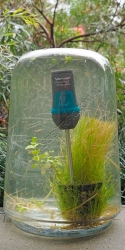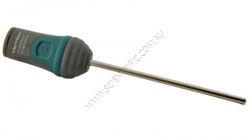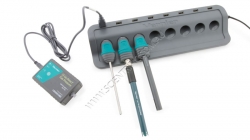
The GDX-TMP can be submerged in water up to 1 metre for limited periods.
Enlarge

8 x GDX-TMP in the Teacher's Pack
Enlarge

Included GDX-CRG will recharge multiple Go Direct sensors
Enlarge

The GDX-TMP can be submerged in water up to 1 metre for limited periods.
Enlarge

8 x GDX-TMP in the Teacher's Pack
Enlarge

Included GDX-CRG will recharge multiple Go Direct sensors
Enlarge
Vernier Go Direct Temperature Teacher Pack
Order code: GDX-TMP-TP-INTL| Purchase QTY: (Pack of 8) | 1+ | |||||
|---|---|---|---|---|---|---|
| Scientrific's price | $1,788.00 |
VERNIER GO DIRECT TEMPERATURE PROBE TEACHER PACK
Buy more and save. With Vernier's Go Direct Temperature Teacher Pack you receive eight Vernier Go Direct Temperature Probes and a convenient charging station that allows you to charge the eight Go Direct Temperature Probes at one time.
The charging station also works with most other Vernier Go Direct sensors.
Vernier's water resistant Go Direct Temperature Probe is a rugged, general purpose temperature sensor that students can use to monitor temperature. It connects wirelessly via Bluetooth® or it can be wired via USB to your device.
The Vernier Go Direct Temperature Probe gives students the advantage of go-anywhere, work-anywhere connectivity and its water resistance makes it the most durable Vernier temperature ever released.
Unlike a traditional thermometer, Go Direct Temperature allows students to collect real time temperature measurements of a single instance or over a period of time. Its temperature range and wireless capability make Go Direct Temperature the go-to sensor for real world applications.
The Go Direct Temperature Probe can be used in a variety of experiments:
• Conduct endothermic and exothermic reactions
• Investigate the freezing and melting of water
• Measure the energy content of foods
• Examine the absorption of radiant energy
• Monitor environmental conditions
Water Resistance:
The Go Direct Temperature Probe can be submerged in water for limited periods of time. It has been tested to a depth of one metre for up to 30 minutes. However, submerging the sensor impacts the radio operation by absorbing much of the energy. This may make it difficult or impossible to connect to the sensor while submerged, particularly if there are electrically noisy signals nearby, such as pumps or motors.
Rechargeable Battery — Ready When You Are
The Vernier Go Direct™ robust rechargeable battery offers long battery life and provides always-ready operation. Monitor battery life directly from Vernier's free Graphical Analysis™ app Should the battery run low simply connect the sensor to the charging cable and keep on collecting — no interruptions or inconvenience to you or your students.
Wired or Wireless — The Flexibility to Choose
Vernier's Go Direct™ sensors connect directly to your mobile device, Chromebook or computer using Vernier's free Graphical Analysis™ app. No additional equipment or software purchases are necessary. Vernier Go Direct sensors can be used wired via USB or wirelessly via Bluetooth allowing you to choose the solution best for your classroom or laboratory.
Vernier Graphical Analysis™ Pro includes all the features of the free Vernier Graphical Analysis app, plus enhanced functions for more advanced analysis. Its illustrative experiment videos and interactive graphing capabilities inspire students to explore crucial scientific concepts and analyze data in new complex and insightful ways.
Vernier Graphical Analysis™ Pro is compatible with most Vernier sensors and multiple operating systems and devices.
Specifications:
• Temperature range: –40 to 125°C
• Handle temperature range: –10 to 45°C
• Resolution: 0.07°C
• Connections:
Wireless: Bluetooth
Wired: USB
Included:
• 8 x Vernier Go Direct Temperature sensors
• Vernier Go Direct charging station
• 8 Micro USB Cables
• Quick-start guide
Educational use only:
Vernier and Kidwind products are designed for educational use. They are not appropriate for industrial, medical or commercial applications. Details
Warranty
- Warranty: 5 years (1 year on battery)
Dimensions- Package size (HxWxD): 114x159x356mm
- Packed weight: 1.36kg
Last edited 13th Jan 2025
| Accessories / Spare Parts: | From |
| GDX-CLAMP - Vernier Go Direct Sensor Clamp | $35.00 |
| CB-USB-MICRO - Vernier Micro USB Cable | $12.00 |
| CB-USB-C-MICRO - Vernier Micro USB-C Cable | $22.00 |
| GDX-BAT-300 - Vernier Go Direct 300mAH Replacement Battery | $25.00 |
| Works with: | From |
| GA4 - Vernier Graphical Analysis | |
| Similar Products: | From |
| GDX-TMP - Vernier Go Direct Temperature Probe | $196.00 |
| GDX-WRT - Vernier Go Direct Wide Range Temperature Probe | $345.00 |
| GDX-ST - Vernier Go Direct Surface Temperature Sensor | $246.00 |
| GDX-PH - Vernier Go Direct pH Sensor | $271.00 |
| GDX-ACC - Vernier Go Direct Acceleration Sensor | $286.00 |
| GDX-FOR - Vernier Go Direct Force and Acceleration Sensor | $296.00 |
| GDX-FPH - Vernier Go Direct Tris Compatible Flat pH Sensor | $345.00 |
| GDX-GPH - Vernier Go Direct Glass-Body pH Sensor | $395.00 |
| GDX-CUR - Vernier Go Direct Current Probe | $246.00 |
| GDX-RB - Vernier Go Direct Respiration Belt | $311.00 |
| GDX-RMS - Vernier Go Direct Rotary Motion Sensor | $485.00 |
| GDX-3MG - Vernier Go Direct 3-Axis Magnetic Field Sensor | $246.00 |
| GDX-CON - Vernier Go Direct Conductivity Probe | $321.00 |
| GDX-COL - Vernier Go Direct Colorimeter | $336.00 |
| GDX-DC - Vernier Go Direct Drop Counter | $286.00 |
| GDX-GP - Vernier Go Direct Gas Pressure Sensor | $261.00 |
| GDX-LC - Vernier Go Direct Light and Colour Sensor | $246.00 |
| GDX-MD - Vernier Go Direct Motion Detector | $321.00 |
| GDX-ORP - Vernier Go Direct ORP Sensor | $296.00 |
| GDX-RAD - Vernier Go Direct Radiation Monitor - Geiger Counter | $544.00 |
| GDX-VOLT - Vernier Go Direct Voltage Probe | $236.00 |
| GDX-EA - Vernier Go Direct Electrode Amplifier | $196.00 |
Documents: Catalogue | Vernier Catalogue K-12 | Catalogue | Vernier Catalogue Uni | Catalogue | Scientrific April 2025 Mini Catalogue | Catalogue | Vernier 2025 K-12 Catalogue | Catalogue | Vernier 2025 University Catalogue | | |||||||||||
Note: Prices do NOT include GST or freight



 ,
,